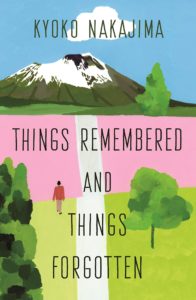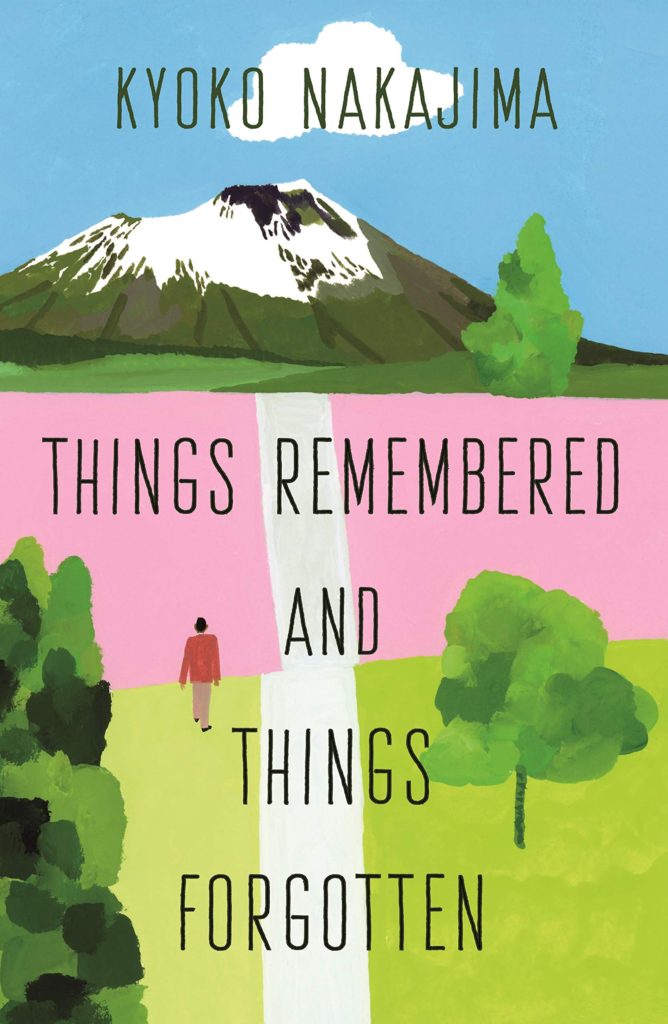Review by Tina deBellegarde
Kyoko Nakajima tackles the past and present, the mundane and the ethereal in her delightful collection of short stories Things Remembered and Things Forgotten, translated by Ginny Tapley Takemori and Ian McCullough MacDonald. The glue that holds these stories together is memory: how the characters remember, wish to remember, or even remember events they never experienced.
This collection includes love stories, narratives of lost memories, and several tales where time-slips and parallel worlds work their magic. Along with other flights of fancy, ghosts make appearances or are implied in almost all the stories. Subtle, charming, they are not always even clearly ghosts, but rather a wish or desire. The apparitions serve a purpose; they are there to blur the past and present, and as they do, they blur reality as well. As readers we begin to understand that perhaps some of the ghosts aren’t there at all, that the character’s desire for the encounter is enough for it to transpire.
Among my favorites, in “Kirara’s Paper Plane” (transl. MacDonald) a ghost remembers when he was alive, and in “The Life of a Sewing Machine” (transl. Takemori) a thrift shop customer experiences nostalgia for times and places she’s never seen, setting the stage for the telling of the “life” of a dilapidated old sewing machine. Through the history of the appliance we learn the evolving struggles of the humans in its orbit. These two stories are particularly rich in cultural and historical details of wartime Japan. They demonstrate how the war, post-war and then modernity changed the world these characters inhabited and how that, in turn, shaped them. The translators are very successful in conveying the nuances of the culture of Japan while not losing the intimacy or immediacy of the story.
“When My Wife Was a Shiitake” (transl. Takemori) is the most fanciful in the collection. A grieving widower is introduced to an unknown side of his wife when he discovers her cooking journal. In it she shares not only recipes but her reflections on life. One of her musings is about remembering when she was a shiitake; she lingers in this memory with all her senses. He learns to cook, fashions a new memory of his wife, and soon he too learns to remember when he was a shiitake.
The final and capstone story is the longest and my personal favorite. In “The Last Obon,” (transl. MacDonald) all the elements of the prior stories converge. Here memories lost and found blur, and the corporeal and the ethereal are indistinguishable. It is also the story where the main character is most self-aware. As Satsuki prepares the festival to honor her ancestors, the last Obon in her ancestral home before it is sold, her faulty memory causes her to stumble through the process. Consequently, each event, conversation, and image evokes a faint memory, reminds her of her childhood, and dredges up long forgotten memories.
“…an image flitted through her mind of her and her two sisters running around the garden with some children whose names she had long since forgotten. Who was the girl in a red pinafore she was chasing? Satsuki sensed that her real childhood had been gradually overwritten with scenes from movies and TV shows set in an imagined, nostalgic past, and the unexpected shallowness of her memories appalled her.” (p. 233)
Finally, Satsuki comes to the realization that her intentional engagement with her ancestors allows the past to take its rightful place.
“Obon wasn’t something mystical or paranormal, nor was it a metaphor for human existence – it was an expression of how the dead were resurrected through the gestures and actions of the living in the performance of traditional customs and practices.” (p. 256)
Each story in Things Remembered and Things Forgotten shimmers with nostalgia and delight, yet at the same time reminds us how ineffective our memory is. The inaccuracy of our recollections and our desire to remember things a certain way blur our reality and intrude on our ability to see the present clearly. These stories assure us that we are not alone in these shortcomings. This collection leaves the characters and reader with the unsettling yet familiar feeling of trying to remember something just beyond reach.
For more on Japanese short stories, see the BOA Issue 8: The Art of the Short Story where you’ll also find a podcast episode with Tina deBellegarde about what makes a good short story and why some short-story writers are so appealing.
About the Reviewer:
Tina deBellegarde’s debut novel, Winter Witness, is nominated for the 2020 Agatha Award for Best First Novel. Her story “Tokyo Stranger” appears alongside celebrated authors in the Mystery Writers of America anthology When a Stranger Comes to Town. Tina lives in New York with her husband Denis where they harvest shiitake mushrooms and tend to their beehives. She travels to Japan regularly to visit her son Alessandro. Visit her website.


